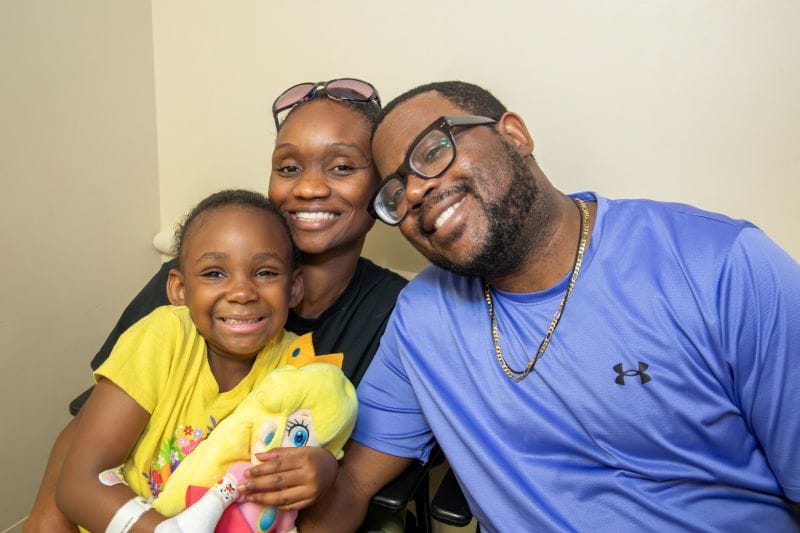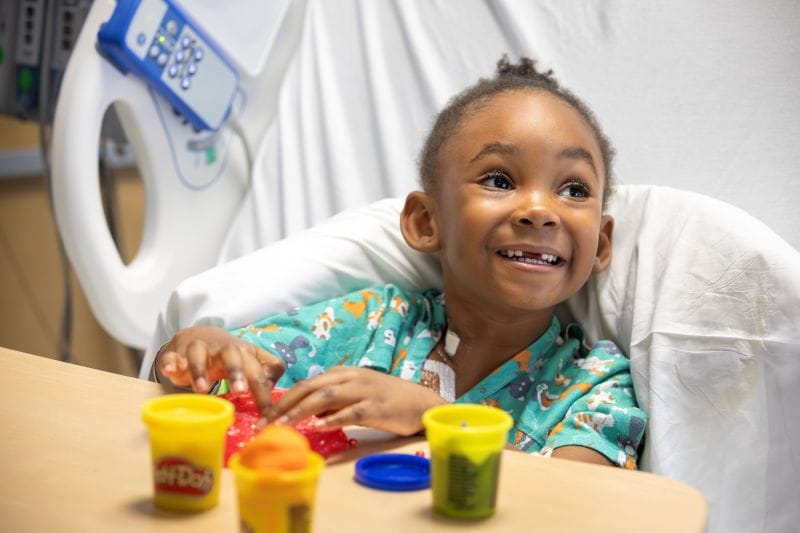Aliyah is Cured of Sickle Cell Disease at Johns Hopkins All Children’s Hospital
Aliyah and Alijah will forever share a very special bond — and it goes far beyond being brother and sister.
Aliyah was born with sickle cell disease, the most common form of inherited blood disorder. Her brother, Alijah, did not have sickle cell and was a 100% match as a potential bone marrow donor.
Sickle cell disease can include the sudden onset of pain called “sickle cell crisis” because of blocked blood flow to surrounding tissues and often requires medical attention.
The only cure for sickle cell disease is a bone marrow transplant, but finding the right donor can be challenging. Siblings often make good bone marrow donors, but in the case of sickle cell, a sibling often also has the disease.
This is where Alijah — who did not inherit the disease — comes in.
Sickle Cell Disease: The Beginning
When Alijah was conceived, his mother Terri knew she was a carrier of the sickle cell trait. However, Terri and her husband Narada didn’t realize he too was a carrier until their OB-GYN suggested Narada get tested. They were relieved that Alijah did not have the sickle trait nor the disease, however Aliyah wasn’t as fortunate.
Doctors soon confirmed Aliyah had sickle cell disease.
Terri’s cousin who has a doctorate degree and studies sickle cell, connected the family to sickle cell specialists at Johns Hopkins All Children’s Hospital in St. Petersburg, Florida.

A Miracle in the Making
When Aliyah turned 3, she began having serious spleen issues due to her sickle cell disease. After the second episode, the medical protocol is to remove the spleen.
“I prayed about it and told the doctors, ‘I respect your position, but I don’t feel this is the right time to remove it,’” Terri says. “The Lord Jesus told me he was going to heal her.”
Terri began to learn about bone marrow transplant (BMT) as an option for sickle cell treatment.
“I thought, OK, well maybe this is an answer to my prayers,” Terri says. “I called the doctors back and asked if a BMT was an option instead of a spleen removal.”
Carrie Gann, a nurse practitioner in the sickle cell program, told Terri that a cheek swab could be used to test for a sibling match. Terri suggested testing Alijah.
“Turns out he was a 100% match for a bone marrow transplant that could potentially cure her of sickle cell disease,” Terri says. “When we told Alijah that he was a perfect match for his sister and his bone marrow could save her life, he got very excited at first. When we came home, we explained that donating bone marrow stem cells requires agreeing to have stem cells drawn from either your blood or bone marrow to be given to someone else.”
“He is terrified of needles and at first said no due fear of getting blood drawn. We told him it was OK. We understand. If you change your mind let us know. He was 8 years old at this point, and we are asking a lot of him. We told him we were not pressuring him to do anything he didn’t want to do. We always reassured him we were not upset with him.”
The Perfect Age
A bone marrow transplant for sickle cell disease involves replacing the patient's faulty blood-forming cells with healthy stem cells from a donor. This process typically includes chemotherapy and/or radiation to prepare the patient's bone marrow for the new cells, followed by the infusion of donor stem cells through an IV, similar to a blood transfusion.
“Every single appointment they educated us about the disease and medications,” Terri says. “They addressed all our concerns and really treated us like family.”
“Aliyah was the perfect age,” says Minelys M. Alicea Marrero, a pediatric hematologist-oncologist specializing in blood and marrow transplants in the Johns Hopkins All Children’s Cancer & Blood Disorders Institute.
As Alijah got older and realized his Aliyah was becoming sicker, he decided to be the donor. His mother recalls him saying: “That’s my sister. I don’t want to see her suffer anymore. I want to do what it takes to make her better.”
“That made me cry,” Terri says. “We arranged for him to speak to counselors and the medical team without us being in the room to confirm he understood the surgical processes and that he was not being pressured.”

Last-Minute Uncertainty
Alijah arrived at the hospital for his bone marrow donation feeling excited that he was going to help his sister feel better. But as he entered the pre-operative area, he had a panic attack.
“We were not expecting that,” Terri says. “I told him, I understand you are scared to be put to sleep, but your sister has already started the chemotherapy, and we can’t turn back now. That’s when the Child Life team got involved to help us. They were a great help to explain the process of anesthesia.”
“Finally, I just laid down on his gurney and hugged him tightly, reassuring him everything would be OK. Then they rolled us both into the OR. When he woke up an hour later, Alijah said, ‘When are they going to do this?’ When we told him it was all over, he said, ‘Mommy, I did it! … I did it!”
“To this day, Alijah tells everyone, he helped heal his sister and save her life,” Terri says.
A Bright Future
The tests confirmed that the transplant was a success, and Aliyah was sickle cell free.
“Before this, I had no idea that sickle cell disease could be cured,” Terri says. “Today, Aliyah is full of energy, like any 5-year-old kid,” says Terri. “We are now working our way toward a normal family life and do not have to worry anymore about her having a sickle cell crisis.”
READ MORE from John's Hopkins All Children's Hospital:
- Carson’s Journey: Positivity, Purpose, and the Power of Giving
- Full Circle at Johns Hopkins All Children’s Hospital
- Growing For All Children at Johns Hopkins All Children’s Hospital – NEW Wesley Chapel Hospital Coming Soon!
*Presented by Johns Hopkins All Children's Hospital | Originally published in the September 2025 issue of Tampa Bay Parenting Magazine.


